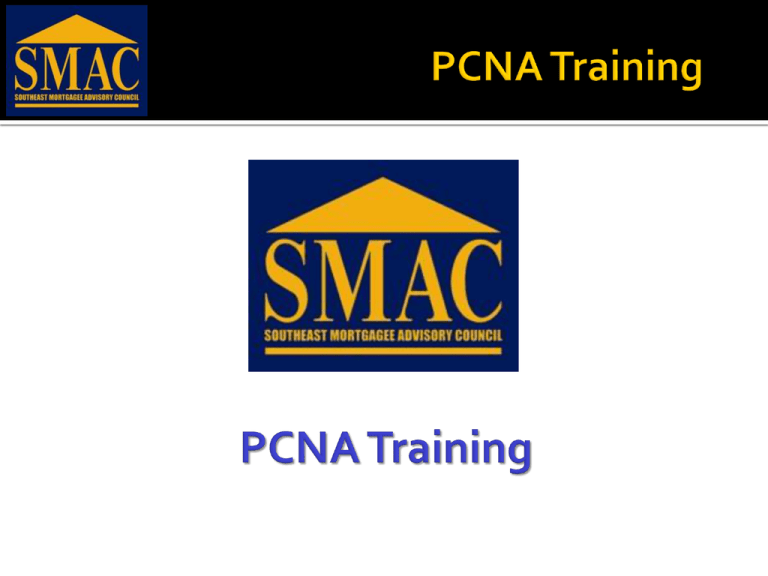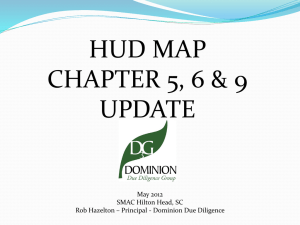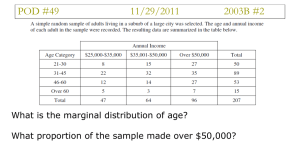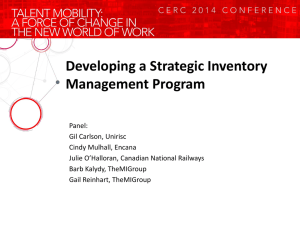PCNA Training - smaconline.net
advertisement

What we hope to accomplish today includes: • Provide guidance on how to perform those roles and • • • • responsibilities Provide HUD with more complete reports from the third parties and analysis from the lenders Manage expectations for all parties Clear up any misconceptions Share ideas References for information in the training includes: • MAP Guide • Mortgagee Letter 2012-25 • Housing Notice 2012-27 • FAQ Dated 2-5-13 • Fair Housing Act • Section 504 of the Rehabilitation Act of 1973 • Americans with Disabilities Act of 1990 • Many Years’ Experience • Common Sense When screening a potential deal, a lender is looking at: • • • • Age of the property Photos of the property (provided by borrower or found online) Aerial Map (Bing, Google, Mapquest) Information provided by the borrower (List of repairs done or to be done) • Information gathered from online searches • Type of Property • Garden, mid-rise, high-rise, brownstone • Market or Affordable After Engagement, information obtained from these items will help determine the scope of work for engagement of the report Hot Button Items • Scope of Work - Standard or Intrusive • • • • Age Exteriors Type of Construction Size of Property (# of units and/or Acres) • Timing • Borrower’s expectations • Our Expectations • 3rd Party Expectations Hot Button Items • IDRR or ADRR • How does either affect the potential DSC Loan Amount? • Does the borrower want one or both high or low? • Type of Construction • Size of Property (# of units and/or Acres) • Timing/Price • Borrower’s expectations • Our Expectations • 3rd Party Expectations • What are you getting for the price? Hot Button Items • Qualifications of 3rd Party Reviewer – What to look for • Staffing – contract or actual staff • Get sample of work to review • List of other lenders and HUD offices • Communication • How much and what type? • Who is your contact from the 3rd party? • Getting everyone on the same page - Technical Scope of Work i. Specifying the assessment protocols • Loan Program (223f, 221d4, A(7), etc.) • Current insured status (if Yes, what current program?) • Is there federal assistance outside of mortgage insurance? • Intrusive or Seismic Zone considerations? • Environmental, and if so what out of scope services do you need? ii. Acquisition vs refinance. • If so, does purchaser/borrower expect reliance on our reporting? iii. Property Details • Size of asset (land size, building size, GSF, # units) • Detailed description (residential and non-residential) • Date of Construction (If built in phases, more info needed!) iv. If >~30 years old, if rehab has been done what level of rehab? SO MANY QUESTIONS, SO LITTLE ANSWERS Timing -You want it when? i. 3-legged stool concept - You can pick two, but not all three! ii. What is acceptable time to get a study completed? 21-25 business days from engagement is industry standard, but you can pay for speed…. iii. Having the correct contact person to site up the site visit is critical; this can be done through the lender, owner or on-site management. IS QUALITY REALLY AN OPTION WITH HUD-FHA? Pricing the Study i. What goes into the price? • Size of asset, type of asset, # units, # buildings • Transaction Protocols (refinance, acquisition, LIHTC, Green, RAD, etc.) • Turnaround time • Location (travel expenses, lodging expenses, etc.) • Are plans available and if so, this can create efficiencies • If UFAS; or post-1991 more advanced accessibility studies are required • Borrower experience with FHA financing • Intrusive Study requirements; “All-in” now, or a staged or phased approach to potential future inspections? • Scheduling the “right person” for the “right job” WHICH DO YOU WANT? A DEFINED SCOPE OF WORK, OR A PRESUMMED SCOPE OF WORK? Managing Client Expectations i. ii. Single point of contact for both lender and assessor Establish a “Path to Success!” • Lender should define expectations of timing • Lender should provide a verified single point of site contact • Lender should define communication process iii. It would be nice to know up-front a borrower’s expectations as far as what the originator promised (e.g. C, NC, R4R, IDRR, ADRR) iv. Some lenders want to control the process, others want to step back and just give the needs assessor the “keys to the car” - What is your style? What is the best style? PROVIDE A TARGET! Communication – Who’s on First? i. ii. iii. iv. A SPOC is key, otherwise the message gets lost Kick-off calls are recommended, especially for sensitive projects The Lender’s individual communication style needs to be communicated Importance of Owner/User/Borrower questionnaire - too often these are not completed putting needs assessors “in the dark” v. Replacement history is so very important vi. Cost of typical replacement items can also be very important vii. Please provide requested documents up front, not after draft! • Obtaining Information from: • The Lender • The Sponsor • Other Sources • Recent HUD Changes • ML-2012-25 • Appendix 6 • HN 2012-27 (Handouts) • Form HUD 92329 • New Format Per FAQ 2/25/13 (Handout) • Form HUD 92264 • Engineer’s Portion (Handout) • ASTM E2018-08 • Is This The Gold Standard? • Why Is This Required? • Checklist / Questionnaire • Is This Really Necessary? • If So, Why? • ALTA / ACSM Land Title Survey • Why Is That Guy’s Fence On My Property? • Title Search / Commitment / Policy • Importance For Engineering • M & B – Legal Description • Tax Assessor’s Information • What Might This Offer Us? • Touch Base With The Appraiser • The Earlier The Better • Who’s On First With NRSF And GBA • What The Heck Does Paint to Paint Mean, Anyway? (Handout) • Building Code • What Do You Mean I Have To Clear My 551 Violations Prior To Closing? (Office Nuances) • Fire • So, Do Expired Extinguishers Really Matter, and • Why Does It Take 60 Days? • Zoning Code • What Do You Mean I Can Only Rebuild 8 Of My 15 Stories? • FEMA • Why Are My Ferragamos Wet and Who The Heck Is This Pushy USACOE? • SHPO • What Do You Mean I Can’t Paint My Windows? • Noise • But It Only Goes 15 MPH • I Think That Airport Is Closed Now • Seismic • No Longer Your Father’s PML • ASCE-31 & 41 • Property Contacts • No, The Janitor Can’t Do It All • Equipment Needed • Standard • Intrusive • Should Lender Rep And / Or Appraiser Come On The Same Day as Needs Assessor? • Why the Engineer Takes Days and the Appraiser Takes Hours • Arrival: (Arrive early to drive the site and get familiar) • Allows for quick study of “lay of the land” and to identify any discrepancies from the pre-site information • General understanding of site … layout and size • General understanding of site features and “unusual” site features • Note any concerns based on drive through and photograph • Meeting with Property Management: • Prefer manager and maintenance staff be present • Introductions and explanation of PCNA • Discuss Purpose and Methodology • Review the existing Reserves and maintenance/operation expenses • Carpet/paint at unit turn vs. inclusion in RUL • Verify unit keys are pulled and staff is available to accompany you • Check staff schedules – lunch, breaks, etc. and affect on timing • Check on status of Property Questionnaire and review if needed • Check on extent and condition of existing drawings to be provided • This tells you what and how to quantify information in field • Walking the Property – Site and Grounds: • Walk site for visual inspection (use of site map or Google Earth image) • Note general site elements and condition • Take general site photographs and repair photographs • Generate site questions list for review with manager/maintenance • Check for accessibility requirements on site • Points of access and accessible entries • Accessible routes • Accessible parking • Check for site elements and special features on site • Utilities, retaining walls, fencing, paths, amenities, etc. • Site measurements, quantities and area take-offs • Walking the Property – Building Exteriors: • Walk each building for visual inspection (use of site map) • Note general building elements, condition and repairs • Note repairs and photo locations on site maps or input through the use of iPad/Tablet technology • Take building photographs and repair photographs • Generate repair list and identify any potential for intrusive tests • Access to roofs - ladders • Take-offs and measurements for any/all needed quantities • On site field measurements may depend on plans available • Walking the Property – Common Areas and Service Areas: • Walk each building for visual inspection (use of site map) • Stairs, breezeways, exterior walkways, interior common corridors • Community spaces, activity spaces and offices areas • Input information into Common Room Schedule • Attics, basements, crawl spaces, storage areas (if access provided) • Note repairs and photo locations on site/building maps or input through the use of iPad/Tablet technology • Take building photographs and repair photographs • Generate repair list and identify any potential for intrusive tests • Take-offs and measurements for any/all needed quantities • On site field measurements may depend on plans available • Walking the Property – Mechanical Equipment Areas: • Note general/specific equipment elements, condition and repairs • Note repairs and photo locations on maps/plans or input through the use of iPad/Tablet technology • Note make/model, capacity, age and condition • Take building photographs and repair photographs • Generate repair list and identify any potential for intrusive tests • Discuss maintenance/replacement history with staff and check inspection records and maintenance contracts for all equipment • Walking the Property – Dwelling Units: • Typically inspect 25% or more units to get good representation of the dwelling unit conditions (pick random sample including vacant units) • Walk through may dictate the need to see additional units • Typically start unit inspections after 10:00am for various reasons • Use of Unit Forms to note general/specific elements, condition and repairs (walk each unit in same manner) • “Typical” unit forms and paint to paint measurements • Talk briefly with tenants for general/specific concerns (work orders) • Note repairs and photo locations on unit forms and unit plans or input through the use of iPad/Tablet technology • Check unit form for completeness before moving to next unit • Review work orders, common repair items with maintenance • Verify Complete and Accurate Information: • Verify all paperwork and forms are complete and verify repairs • What did we see, where is it and is it quantified? • What does the condition/repair mean ? • Intrusive testing – is there reason for testing? • Any water, mold, pests, housekeeping concerns? • What are probable costs? • Review general observations, repair items and concerns with manager and maintenance staff prior to leaving • Identify and discuss any areas of concern for intrusive testing needs that would require an additional visit to the site Field Info Review and Verification i. ii. iii. iv. Field Notes – Should include the inspectors remaining useful life of each replacement item, not just the RUL based on the component’s age Photographs: What should be captured to paint the picture? Property Specific Exhibits • Repair/capital expenditure records • Trades and Specialty Contractor reports (e.g. Elevator, FP, pest, etc.) • Construction Documents (if available) • If past rehab – need schedule or work completed • Other studies (e.g. environmental and haz mat can be very important) Other Potential Submittals / Discoverables? • Municipal Exhibits • Fire Letter • Building Code Compliance • Zoning • Other (e.g. health department with septic or grease trap) Field Notes Best Practices i. Field Note collection Best Practices: • Reproducible record of inspection • Photographic evidence (logical order, chronological order) consist with note collection. • Collection of actual measurements for Accessibility Compliance • Collection of energy consumption data for Green/Energy Audit studies • Environmental Notes? • Notes in Clear, Reproducible Condition (proverbial hit by the bus scenario) • Various methods of data collection: Pros and Cons a. Pen and Paper b. Digital • Notes should facility a timely data validation inspection, as well as report writing by persons other than inspector “Red Flag” Lender Discussions RED FLAG Communication – Best Practices i. Red Flags • Large Cost Items • Significant Accessibility Issues • Barriers to Mortgage Insurance • Additional Investigations ii. These complications should be relayed Lender as soon as possible! iii. Needs assessors should not delay bad news to the draft report issuance. Working Through the Issues i. ii. iii. iv. FHA Accessibility Issues – Someone always wants to point the finger UFAS issues - Interpretation of 24 CFR Part 8.23(b) and what is required Definition of Adaptable? Borrower documentation is key. Examples being… Roofing! • Request specific capital expenditure records • Provide information for contested large building system age and cost v. EULs are just that “Estimated” vi. Cost per Item is negotiable (as long as cost source is documented) MANY OF THE ITEMS ON THE BACKEND OF REPORTING, COULD HAVE BEEN PROVIDED ON THE FRONT END! Never having to say goodbye i. It is not uncommon that the Data Validation and Analysis piece of a needs assessment requires post-inspection site contact, including: • A need for more information • Rectification of photographs with notes on ages and conditions • Request capital expense records to support visual observations • Request environmental data, plans and specs, surveys, etc. • Intrusive studies - contact information for their service contractors • Following up on other site observations that need clarify for reporting • Review photos of any work that was completed after the site visit • And especially in resolving any Red Flag issues! The Narrative Report i. ii. iii. iv. v. vi. Report Format ASTM 2018 w/out of scope considerations Definition of HUD “Out of Scope” requirements Critical, Non-Critical, R4R items: Definition of each How much narrative is too little, or too much? Do we need to paint the picture, or just state repairs? All identified repairs should be reproducible in the field, e.g. meaning the description for each repair should allow for ANYONE to visit the site and find the deficiency. Need item being replaced, the quantity and location for every repair. Can’t simply state replace 10% of the soffits. THE NEEDS ASSESSOR MUST PAINT THE PICTURE! The Reserves for Replacement i. ii. iii. iv. v. vi. vii. What goes in the R4R tables? What is maintenance expense vs. capitalized expense and what data must be provided by client. Who’s Job is this? EULs and RULs: What do they mean? Where do they come from? Accuracy? Are they absolute or rigid? Family vs. Elderly designation. Use group = wear-n-tear Cost Database Alternatives: What are typical construction cost databases or sources? Inflation factors used and why Funding Schedule Dynamics: The Yin and Yang of Sources and Uses DATA INPUT = DATA OUTPUT (e.g. more information on the front end can make the process smoother) The Yin & Yang of the PCNA The Balancing Act SOURCES USES or NEEDS Specific HUD Forms i. Form 92264 preparation • What sections are for the needs assessor? • Whose square footage do we use, PCNA or Appraiser? • Who does Net Leasable Square Foot (NLSF) measurements? ii. Form 92329 preparation (The right way, vs. the wrong way!) iii. Is the 2447 form required or not? iv. Other Potential Forms, deal specific: • RAD Excel Tool • HUD Form 4.4 for RAD deals • Other Source Forms (FHLB, SFHA, etc.) Discussing the Draft Report w/Client i. ii. Purpose of the draft Delivery and Discussion • E-mail, Phone, Conference Call….best media? • Who should be included in the discussions? iii. Comments and Requests for Revisions • Timely submission of clear and concise comments • One unified set of comments • Lenders should establish set protocols for submission of concerns, questions, and requested revisions. iv. Delivery of documents after Report Draft submission • ALTA Survey • Environmental Reports • Others? v. Common issues and how to work through them vi. What is negotiable and what is not The underwriter must be able to locate and understand the relevant parts of a Physical Inspection Report (PIR). • • • Perform basic analysis of an existing property’s condition (acquisition and refinance applications) Identify the key sections of the assessment report: PCNA Accessibility Life and safety issues Identify assessor’s opinion of remaining useful life of property and compare this to appraiser’s opinion of remaining economic life The underwriter must either approve or adjust the escrows. • Compare the report’s resources and needs for the property to your conclusions from the prior steps • Review timing and cost estimates for each repair for the first 2 years, as well as the source for the repair funds • Provide a schedule of expected replacements • Determine the amount of escrows for the approved schedule of capital replacements • Calculate initial and ongoing deposits for the R4R Resources and Needs The underwriter compares the proposed schedule to the findings of the inspection. • Match the replacement schedule to the narrative. • Review the critical versus non-critical allocation of repairs. • Review the effect of immediate (or recent) repairs on the replacement schedule. 1. Critical Repairs Endanger the safety and well-being of residents, visitors and passersby; Adversely affect ingress or egress; or Prevent the project from maintaining sustaining occupancy. 2. Non-Critical Repairs Everything else EXCEPT – 3. Fair Housing Act or ADA Noncompliance Minimum Property Standards The underwriter relies heavily on the inspector to assure compliance with these property requirements. HUD Minimum Property Standards Applicable Building Codes Accessibility Laws: Fair Housing Act Americans with Disabilities Act UFAS (if Part 504 is applicable) Energy Efficiency Regional Influences (Coastal, Seismec) Costs of Repairs Costs may be estimated by inspector or provided by borrower Costs as underwritten will govern the amount available to pay for repairs after closing If under-estimated, borrower will have to provide cash to complete repairs If over-estimated, mortgage may have to be prepaid by the overage Costs used in reserve analysis have a major impact on the outcome, and estimation errors are compounded Resources and Needs Before making a final determination of the reserve schedule for a property, the underwriter compares the proposed schedule to the findings of the inspection. Review the effect of immediate (or recent) repairs on the replacement schedule. War stories abound – Assessor knows of $1.5MM repair plan, but requires replacement of components in early years of reserve Resources and Needs Before accepting a proposed reserve schedule, the underwriter balances the immediate repair schedule, the replacement schedule, and the initial deposit. Early repair or replacement needs may fall into one of two categories: Immediate repairs Initial deposit Resources and Needs Before accepting a proposed reserve schedule, the underwriter balances the immediate repair schedule, the replacement schedule, and the initial deposit. Future replacement needs may be met by one of two funding means: Annual deposits Initial deposit Before accepting a proposed reserve schedule, the underwriter balances the immediate repair schedule, the replacement schedule, and the initial deposit. Annual deposits may be exaggerated by three replacement methods: Repairs that occur early in the life of the loan Repairs paid for by a large single outlay Repairs in years 12 through 20 under present HUD minimum balance rules If initial deposit is too large for borrower… $ $ $ $ The annual deposit can be increased Annual Deposit Initial Deposit Initial Deposit Initial Repairs Annual Deposit Initial Repairs The underwriter must: • Determine the cost of repairs needed to match the physical asset to the appraisal and • Determine the costs to keep the physical asset in good condition for the life of the loan. The underwriter must • Identify which repairs will be deferred • Evaluate the costs and timing of repairs in the PIR • Evaluate owner-proposed repairs not included in the PIR, including costs and timing • Recommend or reject the plan for addressing ongoing capital repairs, including timing, costs, escrows and reserves When A Final is Called For What Happens? • How Many Copies or Why 5 Copies of Each Can Be A Case of Paper • What Type of Things Might Hold Up The Report • Final Code • Final SHPO When A Final is Called For What Happens (continued)? • Photo Selection – Photoshop not needed • Final Hardcore Proofing • Formatting/Ordering (No Not Pizza) • Exhibit Selection for Inclusion • All Original Color or B&W When A Final is Called For What Happens (continued)? • Why All The Blue Ink • Why FedEx • How Many Days is Realistic to Receive Your Reports (5 is Standard But Still Moving) • Final Invoices • Wrapping Up Let’s clear this up…. according to section 5.26B of the MAP Guide…. Physical Inspection Report (needs assessor) + Statement of Resources and Needs (lender) = PCNA The lender and HUD should review the Physical Inspection Report (PIR) to practically the same acceptability standard. • Reading is required to properly review the report. • I guess I still have a job because, apparently, some things get missed from time-to-time! • Reviewing the PIR The easy stuff first • The time between the PIR inspection date and receipt of Firm application cannot exceed 180 days (223f applications). • Needs Assessor Certification as to financial interest,…. • Completed & Signed forms: HUD-92264 (the A&E sections) and HUD-92329, Property Insurance Schedule. • PIR must state the report was done in accordance with: • ASTM E-2018-08 • MAP Guide (at least Chapters 5&6) • Mortgagee Letter 2012-25 (Housing Notice 2012-27) • The report should clearly indicate that there was no significant deviation from the ASTM E-2018-08 standard. (Intrusive examinations may be noted in this section of the report) Reviewing the PIR (continued) • Describe the conditions on the day of the inspection and identify the dwelling units that were observed. Historically, around 25% of units are observed on an average age and condition property. • The Description and Observation section of the report should describe each property component and the condition of that component on the day of inspection. • The good PIRs will connect the replacement of components to the repair list or reserve analysis, such as: Parking area overlay is non-critical repair item #3 • The report should include gross square foot calculations of each structure on the property (MAP Guide, section 5.25.c ). • Poorly written PIRs may encourage follow up inspections by HUD staff to see the property in person or rejection . Reviewing the PIR • Something a little tougher - Obsolescence • Serious consideration must be given to replacement of components that, while functioning, are: • Significantly beyond their Estimated Useful Life (EUL) • 30 year old stoves • Pink tile tub surrounds (unless in art-deco district) • Blue countertops (see pink tile comment above) • Significantly mismatched to associated or nearby components • Upper and lower kitchen cabinets (yes, we know upper cabinets usually last longer, but really???) • Bathtub tile surrounds with mismatched tiles • Windows (bronze and white aren’t complimentary colors) Intrusive Examinations • • • Per the PCNA Mortgagee Letter (2012-25), intrusive examinations are expected to be performed on primary building systems whenever: • The project is 30 or more years old, and • The maximum mortgage term is being requested Intrusive examinations may also be required in other situations (ie: foundation problems, aluminum wiring). Intrusive examinations are a component of the PIR and may be done by the qualified needs assessor (ie: thermo imaging of electric panels and building envelopes, moisture testing of building envelope) or a technical expert hired by the needs assessor (ie: elevators, central boiler or cooling systems). Intrusive Examinations • The PCNA Mortgagee Letter clearly describes the documentation and results of intrusive examinations, such as: • Examiner’s experience and qualifications, • Description of the components examined, • Description of examination methods used, • Estimated age and condition of system examined, • Repair or replacement recommendations (into the repair list), • Estimated remaining useful life of system (reserve analysis). Primary Accessibility Requirements for Existing Properties • Fair Housing, if first occupied after March, 13,1991. • Typically ground floor units (all units if an elevator) • Amenities for resident use (clubhouse, pool area, mail kiosk…) check out www.fairhousingfirst.org for Fair Housing design info • ADA • Rental office and associated parking • Commercial space and associated parking • Section 504, if project-based subsidies (UFAS is design safe-harbor) • 5% of dwelling units (additional 2% for visual impairments) • Amenities for resident use • Accessibility features installed as components are replaced Common Fair Housing Problems Discontinuous Accessible Routes Access Isles with Improper Ramps Obstructed Accessible Routes Common Fair Housing Problem Non-Compliant Molded Fiberglass Tub/Shower Blocking Missing at Tub and Toilet Common ADA Problem Access Isle at the Leasing Office Must be 8 Feet Wide Common Section 504 Problem Separate Kitchen Counter Workspace Missing PIR’s Statement of Accessibility Compliance • Its is not acceptable for the PIR to simply provide a general statement of compliance with the accessibility requirements. • The PIR should provide the detailed methodology used in determining compliance with any accessibility requirements (especially Fair Housing). Indicate the design safe harbor utilized. Details = Reader Confidence • Provide a list of dwelling units that are compliant with the applicable accessibility requirement. Corrective Action Plans (CAP) • CAPs are required when significant accessibility corrections • • • • are needed. CAPs are a stand-alone document providing the detailed and technical description of the accessibility corrections. The detail is such that the CAP can be used by the qualified person to make the correction without error. CAPs may be produced by the needs assessor or other qualified person or entity (ie: architect, engineer). CAPs should have a distinct author and date that can be referenced in the Work Write-Up / Repair List. PCNA Report Photos • • • • • Most PIRs have insufficient photos of the dwelling units. The good reports include much more than the “typical” kitchen and bathroom photos. Photos should illustrate conditions requiring repair, accessibility features and non-compliances. The good reports specifically connect the photos to the conditions described in the report narrative. The photographs should show the good, bad and the ugly. • • • • • • • • • The Reserve Analysis The reserve analysis in the PIR is critically important in estimating the funding needed for future replacements. Problem areas of HUD’s review of the reserve analysis may include: High-end components with low-end replacement costs (ie: stainless appliances, solid surface counters) Component replacements after RUL expiration. Single component replacement spread out over multiple years (ie: parking sealcoating or overlay). Currently uninsured projects, should not have anticipated expenses in the first 2 years of the reserve analysis. Put it in the Repair List. Where is building water line replacement on older projects? Be careful with reserve components in operating budget. Prove it! Evaluate costly replacement items that may occur immediately after the 20 year period, such as a roof replacement in the repair list may roll around again immediately after 20 year reserve analysis period. Will funds be available??? Reviewing the Survey and Other Firm Exhibits • The needs assessor should also review the following: • As-built Survey – buildings encroaching gas line easements and other easements, fall distance of high tension power lines, etc. Phase I Environmental – items such as construction of blast walls, tank removal should be in the repair list. Radon, LBP and Asbestos Reports – mitigation scope should be in the repair list and consistent with reports. • • The Lender’s Statement of Resources and Needs (SRN) • • • • • • • Appendix 5G of the MAP Guide describes the SRN requirements. The lender must indicate that they agree with the PIR’s conclusion or clearly indicate any modifications the lender made and why. Modified exhibits should be presented in their modified form (ie: Repair List). Indicate proposed time period to complete non-critical repairs. Indicate if Critical accessibility repairs will be deferred. The lender presents the complete Reserve Funding Schedule. Any waiver requests affecting architectural exhibits should be highlighted here, but must be in the Underwriter’s narrative. Temporary Relocation Plans should be presented when significant repairs affect dwelling unit bathrooms or kitchens. Temporary Relocation plans are not only needed if a resident is out overnight. Day services or accomodations should be described. The Work Write-Up / Repair List • • • • • Should be a separate list that can be attached as Exhibit A to the Firm Commitment. Exhibit A travels to the escrow agreement at closing (less the critical repairs). When inspecting less than 100% of unit interiors, the inspector should forecast unit repairs as a % across the entire property. Must be descriptive enough that an inspector can verify work was acceptably completed. MAP Guide, Appendix 5G states that for multiple building projects, the Repair List must be itemized for each building. Deferring Accessibility Repairs • • • The lender must specifically and clearly request deferral of accessibility repairs until after closing. HUD will not assume the lender wants to defer accessibility repairs. Accessibility repairs affecting health or safety may not be deferred (ie: pipe insulation). The Work Write-Up / Repair List should be categorized and subtotalled: • Critical Repairs • Deferred Critical Accessibility Repairs • Non-Critical Repairs Non-Critical Repairs and Bids • • • • Supportive bids are required when a repair item is: • $25,000 or more, and • completed after closing. Supportive bids may also be requested by HUD to validate costs that may appear underestimated. The bids should be reviewed and included in the PIR to ensure the bid scope and PIR repair scope is consistent. While there is not a specific age limit on the bids, they should be within 180 days of receipt of application (like the PIR). Lender’s Reserve Funding Schedule • • • • While most PIR’s are attempting the reserve funding schedule, it is the lender’s function/responsibility per Appendix 5G of the MAP Guide. The PCNA Mortgagee Letter states that proposed increases in the annual deposit may not exceed the lender’s, cumulative, projected increases in operating expenses over the same period. The lender must consider that subsidized projects may have limitations on any future increases in the annual deposit. “Tight” funding schedules do not leave room for adjustments to replacement periods or component costs by HUD during review. HUD’s Acceptance of the PCNA • The HUD construction analyst must ultimately decided to recommend acceptance of the PCNA to the HUD underwriter. • However, that acceptance may not mean: • The PCNA was without flaws. • A precedence has been set for future cases. When Should Critical Repairs be Completed? • • Prior to Closing When necessary in cases of applications for new insured financing (acquisitions), completion of such repairs may be deferred beyond Closing • Hub Approval is required • Must be completed within 12 months of Closing • In unusual circumstances, repairs may take more than 12 months. HQ approval is required in these instances • Life and Safety repairs must ALWAYS be completed prior to closing Note: For 10 Year update PCNA reports or PCNA reports completed apart from a new application, Critical Repairs must be completed ASAP When Should Non-Critical Repairs be Completed? • Must be completed within 12 months of Closing, but can be completed prior to Closing • In unusual circumstances, repairs may take more than 12 months. HQ approval is required in these instances • Form HUD-92476.1 M (Escrow Agreement for Non-Critical, Deferred Repairs) must be completed (more on this later) Note: In cash-out transactions, 50% of the cash will be held until repairs are complete How are Owner-Elected Repairs Handled? • Shall be classified as Non-Critical • Must enhance the competitive value of the property to be acceptable • Must be completed within 12 months of Closing, but can be completed prior to Closing Deferred Maintenance and Seismic Repairs • In a refinance transaction, “deferred maintenance” repairs (Critical or Non-Critical) must be completed prior to Closing • In a purchase transaction, “deferred maintenance” non- critical repairs can be completed after Closing • Seismic repairs should be treated as non-critical unless circumstances warrant otherwise How Does the HUD or Lender Verify the Repairs are Complete? • In the MAP Guide, it states that a HUD representative is required to do a site visit to verify repairs • Budgetary issues have made this difficult, at best In lieu of this, the verification is typically done as follows: • Borrower sends in detailed Photos, Invoices • Borrower should label photos by repair items for easy identification • Invoices should be detailed enough to get count of items (i.e. # of Refrigerators replaced) • If less items replaced than suggested by Repair schedule, you need explanation from borrower • Underwriting Team matches those to repair schedule • UW Team updates or finalizes Repair List • UW sends compiled information to HUD Post-Closing Repairs • Complete Form HUD-92476.1 M Escrow Agreement for NonCritical, Deferred Repairs, prior to Closing • Cost of repairs held in cash • Cash or LOC of not less than 20% (sometimes negotiable) will also be placed in escrow • Lender may release funds from the mortgage proceeds in proportion to the cost of the work completed • R4R may not be used for any repairs • If repairs are not complete by end of the repair period (including approved extensions), the Lender is responsible for getting them completed • If costs come in lower, and it is not a cash out mortgage, in most cases the additional funds go to the R4R account Non-Critical Repair Delegation • Mortgagee Letter 2013-13, Lender Delegation of NonCritical Repair Administration • Authorizes delegation of non-critical repairs administration for MAP 223(a)(7) and 223(f) programs • Eliminates need for HUD approval of escrow releases (with exception of final draw) • Expedites escrow release process • Lenders must submit a request and be approved to participate • HUD Inspection Fee waived if repairs total less than $100,000 Non-Critical Repair Delegation – Process • • • • • • • Lender’s Application must specify that they will assume noncritical escrow administration Firm Commitment will include this as a Special Condition Firm Commitment will include a Draw Schedule • Draw schedule is somewhat dependent on scope of repairs PCNA Reviewer is typically firm to perform inspections # of Inspections vary based on amount and timing of repairs Final draw is approved by HUD Supplemental Cost Certification is required under certain circumstance








